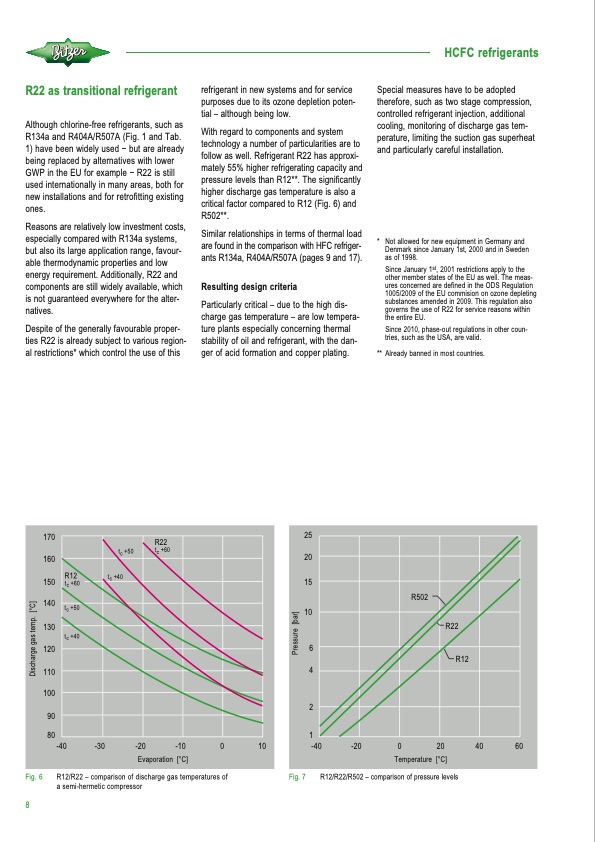
PDF Publication Title:
Text from PDF Page: 008
R22 as transitional refrigerant Although chlorine-free refrigerants, such as R134a and R404A/R507A (Fig. 1 and Tab. 1) have been widely used − but are already being replaced by alternatives with lower GWP in the EU for example − R22 is still used internationally in many areas, both for new installations and for retrofitting existing ones. Reasons are relatively low investment costs, especially compared with R134a systems, but also its large application range, favour- able thermodynamic properties and low energy requirement. Additionally, R22 and components are still widely available, which is not guaranteed everywhere for the alter- natives. Despite of the generally favourable proper- ties R22 is already subject to various region- al restrictions* which control the use of this refrigerant in new systems and for service purposes due to its ozone depletion poten- tial – although being low. With regard to components and system technology a number of particularities are to follow as well. Refrigerant R22 has approxi- mately 55% higher refrigerating capacity and pressure levels than R12**. The significantly higher discharge gas temperature is also a critical factor compared to R12 (Fig. 6) and R502**. Similar relationships in terms of thermal load are found in the comparison with HFC refriger- ants R134a, R404A/R507A (pages 9 and 17). Resulting design criteria Particularly critical – due to the high dis- charge gas temperature – are low tempera- ture plants especially concerning thermal stability of oil and refrigerant, with the dan- ger of acid formation and copper plating. Special measures have to be adopted therefore, such as two stage compression, controlled refrigerant injection, additional cooling, monitoring of discharge gas tem- perature, limiting the suction gas superheat and particularly careful installation. * Not allowed for new equipment in Germany and Denmark since January 1st, 2000 and in Sweden as of 1998. Since January 1st, 2001 restrictions apply to the other member states of the EU as well. The meas- ures concerned are defined in the ODS Regulation 1005/2009 of the EU commision on ozone depleting substances amended in 2009. This regulation also governs the use of R22 for service reasons within the entire EU. Since 2010, phase-out regulations in other coun- tries, such as the USA, are valid. ** Already banned in most countries. HCFC refrigerants ��� ��� ��� ��� ��� ��� ��� ��� �� �� ��� ��� ��� ��� � �� ����������� ���� �� ��� ��� �� ��� ��� �� ��� �� ��� �� ��� �� ��� �� �� �� �� � � � � ��� ��� � �� �� �� ����������� ���� ���� ��� ��� Fig. 6 R12/R22 – comparison of discharge gas temperatures of Fig. 7 R12/R22/R502 – comparison of pressure levels a semi-hermetic compressor 8 ����������������� ���� �������� �����PDF Image | REFRIGERANT REPORT 21

PDF Search Title:
REFRIGERANT REPORT 21Original File Name Searched:
A-501-21_EN.pdfDIY PDF Search: Google It | Yahoo | Bing
CO2 Organic Rankine Cycle Experimenter Platform The supercritical CO2 phase change system is both a heat pump and organic rankine cycle which can be used for those purposes and as a supercritical extractor for advanced subcritical and supercritical extraction technology. Uses include producing nanoparticles, precious metal CO2 extraction, lithium battery recycling, and other applications... More Info
Heat Pumps CO2 ORC Heat Pump System Platform More Info
| CONTACT TEL: 608-238-6001 Email: greg@infinityturbine.com | RSS | AMP |